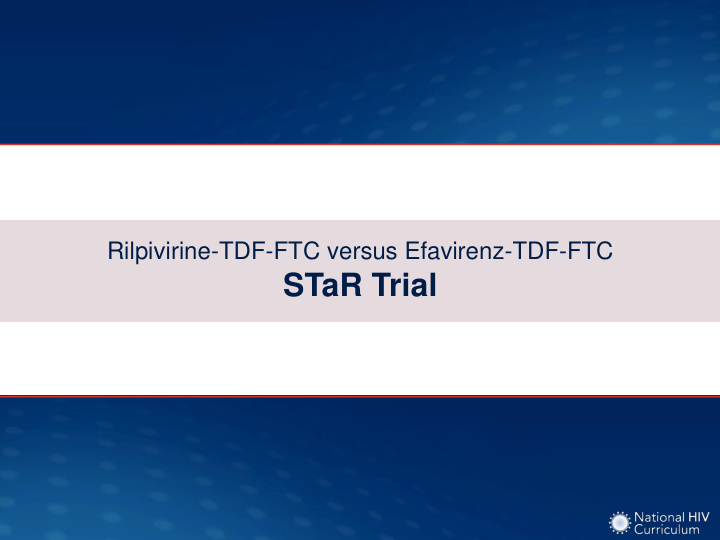



Rilpivirine-TDF-FTC versus Efavirenz-TDF-FTC STaR Trial
Rilpivirine-TDF-FTC versus Efavirenz-TDF-FTC STaR Study: Design Study Design: STaR Study • Background : Randomized, open label, phase 3b trial comparing safety and efficacy of two single- tablet regimens, RPV-TDF-FTC and EFV-TDF- Rilpivirine-TDF-FTC QD FTC, in treatment-naïve adults with HIV (n = 394) • Inclusion Criteria (n = 786) - Antiretroviral-naïve adults - Age >18 years - HIV RNA ≥2500 copies/mL - No resistance to EFV, RPV, TDF, or FTC Efavirenz-TDF-FTC QD (n = 392) • Treatment Arms - Rilpivirine-tenofovir DF-emtricitabine - Efavirenz-tenofovir DF-emtricitabine Source: Cohen C, et al. AIDS. 2014;28:989-97.
Rilpivirine-TDF-FTC versus Efavirenz-TDF-FTC STaR: Result Week 48 Virologic Response (Intent-to-Treat Analysis) RPV-TDF-FTC EFV-TDF-FTC 100 89 86 HIV RNA <50 copies/mL (%) 82 82 82 80 80 60 40 20 338/394 320/392 231/260 204/250 107/134 110/142 0 ≤100,000 copies/mL All >100,000 copies/mL Baseline HIV RNA Source: Cohen C, et al. AIDS. 2014;28:989-97.
Rilpivirine-TDF-FTC versus Efavirenz-TDF-FTC STaR: Result 48 Week Virologic Outcomes RPV-TDF-FTC EFV-TDF-FTC 100 86 82 80 Patients (%) 60 40 20 13 8 6 6 0 Virologic Suppression Virologic Failure Missing Data Source: Cohen C, et al. AIDS. 2014;28:989-97.
Rilpivirine-TDF-FTC versus Efavirenz-TDF-FTC STaR Study: Common Adverse Events Treatment Emergent Adverse Events in > 5% of Subjects in Either Arm RPV-TDF-FTC EFV-TDF-FTC (n = 392) (n = 394) Dizziness 6.6% 22.2% Insomnia 9.6% 14.0% Somnolence 2.5% 6.9% Headache 12.4% 13.5% Abnormal Dreams 5.8% 24.5% Depression 6.6% 8.9% Anxiety 5.1% 8.4% Folliculitis 5.3% 1.0% Rash 6.1% 12.0% Source: Cohen C, et al. AIDS. 2014;28:989-97.
RPV-FTC-TDF versus EFV-FTC-TDF STaR Study: Conclusions from Primary Analysis Conclusion : “In treatment -naive participants, RPV/FTC/TDF demonstrated noninferior efficacy and improved tolerability compared with EFV/FTC/TDF, as well as a statistically significant difference in efficacy for participants with baseline HIV-1 RNA 100,000 copies/ml or less at week 48. ” Source: Cohen C, et al. AIDS. 2014;28:989-97.
Rilpivirine-TDF-FTC versus Efavirenz-TDF-FTC STaR Trial: Week 96 Resistance Data
Rilpivirine-TDF-FTC versus Efavirenz-TDF-FTC STaR Study: Result Development of Genotypic Resistance at Week 48 RPV-TDF-FTC EFV-TDF-FTC 10 8 Patients (%) 6 4.3 4.1 4.1 4 2 0.8 0.8 0.3 0 Resistance to study drugs Any NNRTI resistance Any NRTI resistance Source: Porter D, et al. J Acquir Immune Defic Syndr. 2014;65:318-26.
Rilpivirine-TDF-FTC versus Efavirenz-TDF-FTC STaR Study: Result Development of Resistance to Study Drugs at 48 weeks, by Viral Load RPV-TDF-FTC EFV-TDF-FTC 10 9.0 8 Patients (%) 6 4.3 4 1.9 2 0.8 0.8 0.7 0 ≤100,000 copies/mL All >100,000 copies/mL Baseline HIV RNA Source: Porter D, et al. J Acquir Immune Defic Syndr. 2014;65:318-26. .
RPV-FTC-TDF versus EFV-FTC-TDF STaR Study: Conclusions from Resistance Analysis Population Conclusions : “Among subjects in the primary resistance associated populations (RAP), resistance development to RPV/FTC/TDF consisted of NNRTI and NRTI mutations and was more frequent than resistance development to EFV/FTC/TDF. In subjects with baseline viral load ≤ 100,000 copies/mL, resistance development was low (<2%) for both RPV/FTC/TDF and EFV/FTC/TDF arms and less frequent compared with subjects with baseline viral load >100,000 copies/mL, for RPV/FTC/TDF. ” Source: Porter D, et al. J Acquir Immune Defic Syndr. 2014;65:318-26.
Acknowledgment The National HIV Curriculum is an AIDS Education and Training Center (AETC) Program supported by the Health Resources and Services Administration (HRSA) of the U.S. Department of Health and Human Services (HHS) as part of an award totaling $800,000 with 0% financed with non-governmental sources. This project is led by the University of Washington’s Infectious Diseases Education and Assessment (IDEA) Program. The content in this presentation are those of the author(s) and do not necessarily represent the official views of, nor an endorsement, by HRSA, HHS, or the U.S. Government.
Recommend
More recommend